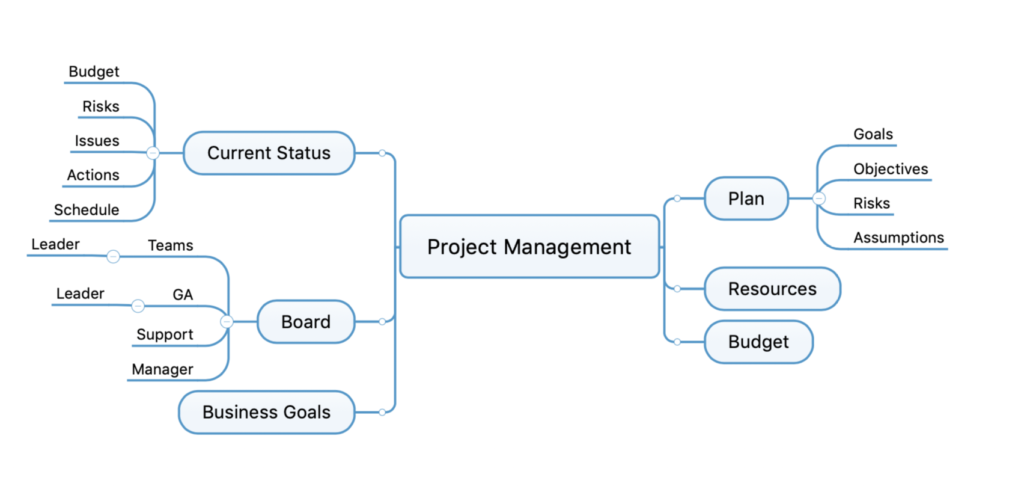Successful project management requires the application of both well-tested methodologies and high-level strategic thinking. Your project management strategy helps team members respond to challenges, increases their efficiency, and enables them to reach goals while staying on time and within budget.
Strategic project management goes beyond focusing only on traditional project management issues such as budgets and timelines. Instead, a strategic approach to project management requires careful selection, prioritization, and allocation of resources to projects that drive organizational success while boosting the bottom line.
As with project management tools and techniques, there is no one-size-fits-all approach to developing a project management strategy. In this article, we will explore the benefits of defining a project management strategy, provide examples of various types of strategies for project management, and explain how using a visual tool can enhance the creation of your project management strategy.
The benefits of strategic project management
As the name suggests, strategic project management focuses on integrating your projects into your organization’s overall strategic plan. Using strategy to tie projects to business goals not only fosters growth and efficiency—the projects themselves tend to be more successful.
The benefits of strategic project management include the following:
- Greater project success rates. When projects are aligned with the greater organizational strategy, they have a better chance of achieving positive outcomes such as meeting the stated business goals, finishing on time, and staying within budget. Companies that do not treat strategy as a core competency of project management, however, experience failure in 67% of their projects on average.
- Increased value creation. Not all projects deliver equal value. For example, those that are not aligned with strategy may deliver some financial benefit but do not necessarily drive business growth. Strategic project management allocates time and resources to high-value projects that bring the organization closer to achieving key goals and KPIs.
- Elimination of waste. A strategic project management process allocates budget bandwidth based on how different projects support key business objectives. This helps eliminate wasted investments stemming from poor project performance since projects that do not support objectives are deprioritized.
How to determine the right project management strategy
There are several project management strategies you can employ to increase project efficiency. Of course, no two projects are identical, so it is important to customize your approach to the unique needs of a particular project. The following are five strategies that project managers can use to guide their projects from beginning to end.:
1. Start with the details
Before you kick off a project, you first need to hash out the details. This helps you establish a clear path to successful completion. Of course, this does not mean that you’re bound to the plan. But as circumstances change and potential issues arise, you’ll be in a better position to adapt and maintain project stability.
Start with the project’s end goals and then identify what needs to happen to reach those objectives. Identify the roles and responsibilities associated with the project so that everyone understands the part they play throughout the project lifecycle. Establish milestones to help keep the project on track and prevent bottlenecks.
2. Establish flexible goals
The goals defined during the project planning phase should be specific, measurable, attainable, relevant, and timely (SMART). They should not, however, be set in stone because your needs can change throughout the project lifecycle.
Therefore, you need to establish clearly defined goals that can be modified in response to changes that impact the project’s scope or timeline. It is a good strategic practice to have contingency plans for potential changes or to mitigate potential problems that may crop up. For example, if product availability could impact a project’s deadline, a solid project management strategy will account for that constraint in the initial plan.
3. Understand the scope
The project scope informs the amount of work to be completed and outlines necessary resources and timelines. Understanding what is (and is not) included in the project scope helps assess how various constraints might impact a project’s success.
Scope also impacts the size of the project, influencing the budget and resource allocation requirements. Project managers use the initial project scope outline to minimize the risk of disruptions or change orders that could affect the project’s timeline. Strategic project management includes implementing control factors early in the process to avoid scope creep.
4. Use the right project management methodology
Working within the right project management methodology goes a long way toward influencing your success in meeting project goals and deliverables. It is important to note that there may not be a single solution that applies to all projects, even within the same organization.
Project managers must analyze and choose the methodology that best suits the needs of a particular project and the project management team. Each methodology has its pros and cons, and each works best under specific circumstances. Choosing the right one is informed by the project’s complexity, duration, available resources and budget, and allowable flexibility.
5. Maximize team collaboration.
Collaboration is key in determining whether your project will achieve the desired outcomes. In fact, a third of all projects fail as a result of poor communication, which has a direct impact on how well team members collaborate. Look for collaboration tools that foster creativity and problem-solving, such as maps that can foster increased sharing and improve a team’s connectedness.
These tools keep teams connected throughout the project lifecycle, increasing efficiency and achieving better results. For example, a solution like MindManager® facilitates collaboration through visual diagrams while allowing enabling team members to directly link data sources and files to items in the diagram. This provides real-time access to project information, allowing helping team members to understand the context of one another’s actions.
How to use mind maps to create a project management strategy
A mind map is a visual way to organize information. Mind maps show relationships between a central idea and its related topics, structuring information the same way our brains do.
Project management mind maps allow enable you to better communicate complex ideas by reducing information overload. Because they present information in a visual format, it is easy for team members to brainstorm and come up with ideas and concepts without having to know exactly how they are related or connected at the outset of the project lifecycle.
With MindManager, creating a mind map is a straightforward process. You start with a central topic, such as the project’s name, and then branch out from the center with connected topics or ideas. Organizing ideas graphically means that you can include as many subtopics, connections, and branches as needed without getting lost in complex documentation.

You can use a mind map to break projects into smaller components, including the stakeholders, resources, team members, contingencies, and other factors necessary for project completion. With the main idea at the core, it is easy to gauge the relative importance of each component by its proximity to the center.
Learn how MindManager brings clarity and structure to your project management strategy.

